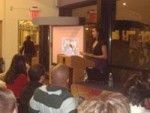Student Projects Explore Diversity

On Monday, February 9 in the African, Latin, Asian and Native American (ALANA) Cultural Center, sophomores Colleen Schneider and Margaret Brower presented their research as part of the Diversity Research Forum. Both Schneider and Brower’s projects examined the lack of diversity both inside and outside of the classroom and proposed ways to remedy the situation. The Forum consists of student research projects on any subject relevant to diversity that students have done for one of their classes. A panel, headed by Associate Professor of Political Science Nina Moore and ALANA Cultural Center Director Thomas Cruz-Soto, selects the forum subjects from projects submitted by professors each semester. The Forum gives each student fifteen minutes to present their findings and proposals for the future, followed by ten minutes for questions.
Schneider’s project, entitled “Moving Toward a Multicultural Pedagogy of Science,” investigated the domination of the sciences by white males. She focused on the science teaching styles used with children in elementary and middle school and the ethnic and socio-economic backgrounds of these children. Schneider argued that the formal way in which science is taught discourages students, especially those from less fortunate backgrounds, from pursuing science as a career.
As an alternative to traditional pedagogy, Schneider suggested inclusive pedagogy, which would present science in a more creative way that would encourage dialogue among students.
“Curricula that seek to homogenize student thinking are colorblind and will therefore not materialize into success for students of color,” Schneider said.
Schneider’s research was done for her American School class last semester.
“My research for my American School class was actually inspired by an article I read for my Philosophy of Religion class about the philosophy of science,” Schneider said. “I started thinking that the way that science is taught excludes certain people. I thought about my education and how I enjoyed certain classes more than others and I wanted to know why that was.”
Brower’s research, “The ‘Have(s)’ and ‘Have Not(s)’ Separated: Sororities and Student Activities on Colgate Campus,” dealt with the lack of diversity in Colgate’s social organizations. Brower began the presentation by explaining the benefits of organizations, such as sororities. Though sororities provide national networking and job opportunities, social outlets and leadership opportunities, they are quite expensive to participate in. According to Brower, the school should make these organizations available to more students by providing them with the finances required to join and participate. She argued that doing so would promote the integration of students from different socio-economic backgrounds. As proposed, these funds would come primarily from alumni and Greek recruitment and would be need-blind.
Much discussion arose amongst audience members following Brower’s presentation. There were many questions concerning whether the lack of integration was the result of monetary unavailability or of a general unwelcoming feeling that some social organizations perpetuate. Some audience members questioned whether a discrepancy between the percentage of students at Colgate on financial aid and the percentage of students in sororities on financial aid even exists, implying that the reasons underlying the lack of integration in such organizations might not be based solely on socio-economic issues.






